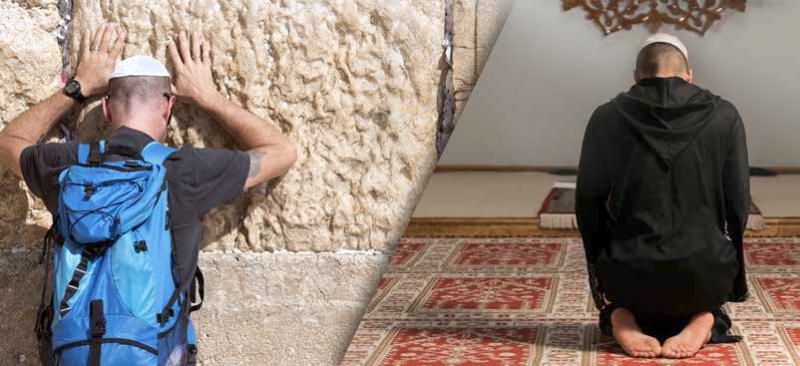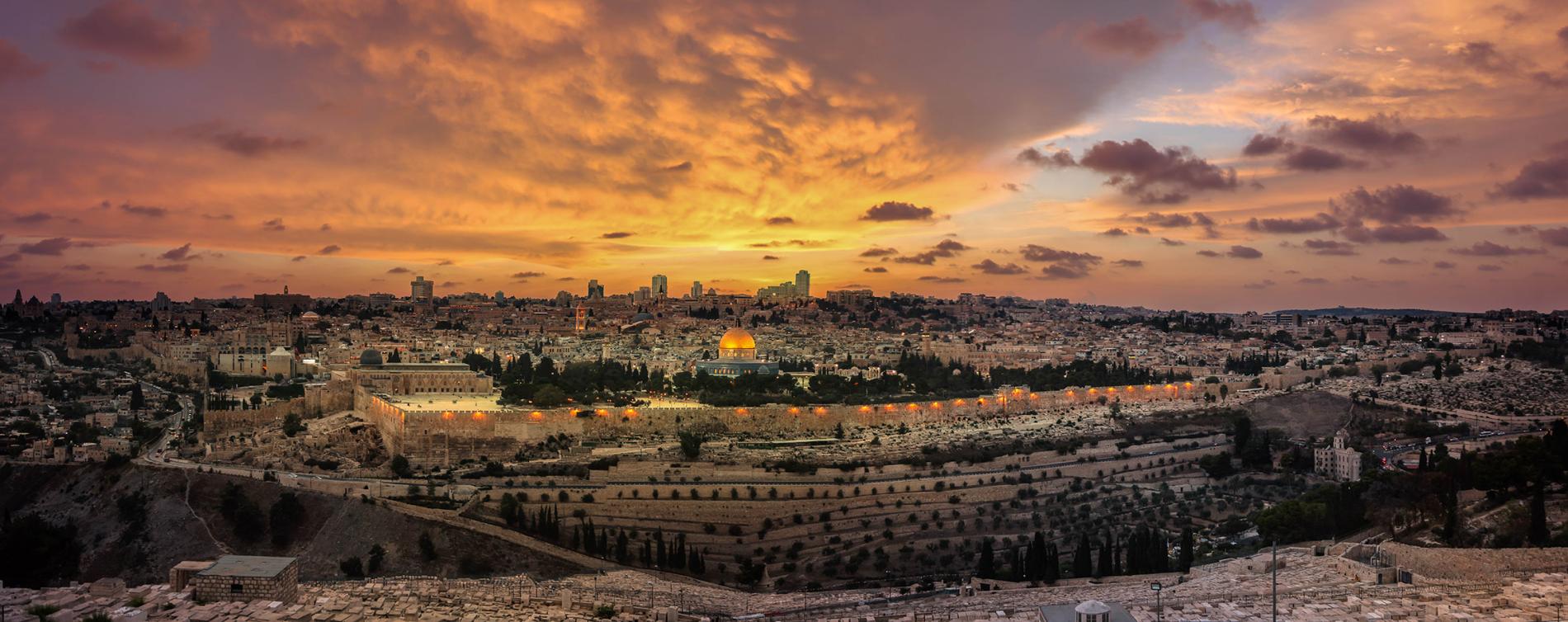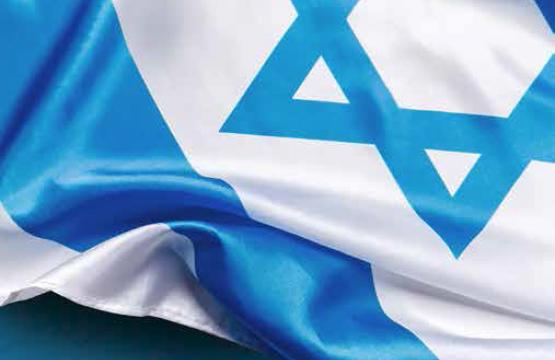
Introduction
The Middle East conflict is the longest-running conflict in history. Arab-Israeli tensions are observed in Genesis – with Sarah, Hagar and Ishmael – much as they are noted in Revelation, when the unleashing of frenzied hordes marshaled east of the Euphrates (i.e., modern Iran) facilitates the climactic battle of Armageddon.
Interestingly, beyond simply bookending the story with intractable Arab-Israeli conflict and conflagration, narration of the major stories lends itself to Arab- Israeli cohesion and resolution. Putting fresh eyes on old stories, and noting how Arabs and Jews are happily woven together throughout them, can help readers get a glimpse of how the biblical narrative can be the basis for spirited conversation, common bonding and eventual reconciliation.
Healing will come to these now-estranged cousins. As you will see, Scripture will help these parties rediscover each other in history and forge new alliances in a common destiny.
Abraham’s Arabian Connections
In Genesis 11:30, Moses matter-of-factly told his readers that Abram took a wife who was “barren.” In chapter 16:2, Moses says she came to terms with it, telling Abram: “...go into my maid [Hagar]; perhaps I shall obtain children by her.” Moses further reported that the young domestic worker was summarily “taken and given to Abram,” in verse 3, and that she eventually conceived in verse 4.
There is no evidence that teen-aged Hagar had any interest in marrying Abraham – who was well advanced in age. A disempowered domestic worker, Hagar seems to have been “pawned off” on him. Sarah commandeered her in the service of her own interests and then, according to verse 6b, “dealt harshly” with her, with the result that much younger and less powerful Hagar “fled from her presence” (verses 6, 8).
Hagar was later told that she’d bear a son named “Ishmael,” that he’d be a strong and “wild man,” and that he’d be neither domesticated nor shackled by the confines of forced submission (verses 11–12).
While strong and “wild” may seem like a negative connotation, it would have been welcomed by the subservient Hagar. Learning that her son will never be shackled and pressed into the service of others, as she was, would have been good news indeed.
That the Lord visited Abraham and said: “I will make a nation of the son of the bondwoman, because he is your seed,” in Genesis 21, verses 12–13, and Ishmael will be a “great nation” in verse 18, would have contributed to an understanding of the grace being extended. God is represented as loving Ishmael, promising a future for him and the Arab peoples generally and as only tolerating Sarah’s flagrant and unkind disregard.
Moses’ Arabian Connections
While Abraham is credited with being the father of the Hebrew race, Moses is credited as being the father of the Hebrew people’s religion. The name “Moses” is actually Egyptian in origin, akin to the famous kings Ramses and Thutmose (i.e., Ra-moses and Tut-moses). Moses really needs no introduction. His wife, on the other hand, needs to be reintroduced – particularly because she was a non-Jewish Arab.
Exodus explains that a young Moses hastily left Egypt and came upon girls watering their flocks at a well in Midian (Exodus 2:16). Though there first, and thus having “first rights” at the well, Exodus indicates that local shepherd boys figured they could get the better of the weaker girls. The boys drove them away from the well and tended to their (own) livestock (verse 17a).
Though Moses didn’t personally know the girls or the boys, he still knew that the weaker shouldn’t be molested by the stronger. Exodus says he “stood up and helped them, and watered their flock” for them, in verse 17b. After the girls told their father about the fortuitous event, in verses 18–19, he invited Moses to their home. Moses stopped by and eventually married into the family. He took a Midianite woman, Zipporah, to be his wife (verse 21). Where was Midian in Moses’ day? Arabia. Moses married an Arab.
Ruth’s Arabian Connections
The outbreak of famine in Judah precipitated a certain Jewish family’s decision to leave the ancestral Israelite homeland and reside in the East, in Moab (Ruth 1:1). Moab is located in modern Jordan. Hospitable Moabites not only welcomed the impoverished Jewish family, but they allowed them to inter-marry with their own. The Hebrew Bible informs that two daughters-in-law married young men in the Jewish family: Ruth and Orpah (verse 4). Tragically, however, in the course of a decade, all the men died off – old and young alike – with the result that only the mother-in-law Naomi was left with her two Moabite daughters-in-law.
Ruth deeply loved Naomi and was not dissuaded by teary and forceful remonstrations beckoning her to go back to the family of her childhood. “Ruth said: ‘Entreat me not to leave you, or to turn back from following after you; for wherever you go, I will go; and wherever you lodge, I will lodge; your people shall be my people, and your God [shall be] my God...” (Ruth 1: 16).
While Orpah turned back as Naomi suggested, Ruth walked into an uncertain future with her mother-in-law (Ruth 1:19–22). Providence is said to have shined upon both. Ruth followed the wise advice of her mother-inlaw, and her own sterling character caught the attention of others in her new home – and one man in particular. Wealthy Boaz became her protector and subsequently married her. Ruth the Midianite became greatgrandmother to King David – and, ultimately, direct ancestor of Jesus (Ruth 4:13–18).
David’s Arabian Connections
David is the actual progenitor of Israel’s royal lineage with his ancestry tracing directly to the Messiah Himself. King David, as we shall see, was very Arab-friendly.
One of King David’s sisters – Abigail (not the same Abigail as his wife) – was given in marriage to Jether the Ishmaelite – one of the descendants of Ishmael. He was an Arab.
“Abigail bore Amasa, and the father of Amasa was Jether the Ishmaelite,” according to 1 Chronicles 2:17. Pause and consider this: an Arab was incorporated through marriage into the royal family of Israel in the zenith of its glory. It was to the son of this interracial marriage – an Arab named Amasa – that David uttered one of his most sincere statements: “You are my brother, my own flesh and blood,” in 2 Samuel 19:13.
In fact, it was to this son, to an Arab, that David swore he’d give command of Israel’s army. “And say to Amasa, ‘Are you not my own flesh and blood? May God deal with me, be it ever so severely, if from now on you are not the commander of my army in place of Joab” (2 Samuel 19:13 NIV). That David would hand his and his nation’s security over to the son of an Arab is significant.
In 1 Chronicles 27:30, “Obil the Ishmaelite” was placed in charge of the camel herds, while “Jaziz the Hagrite” was placed in charge of the flocks (1 Chronicles 27:31). The Hebrew Bible does not insinuate any sense of exclusivity or racism, with Arabs placed high in David’s army. David, the great warrior king, himself gave charge of his Jewish army to an Arab. He also gave Arabs lead positions in commerce and industry. The implications are striking.
Jerusalem Chalkboard Plaque Package (2075)
This package includes:
- Jerusalem Chalkboard Plaque
- A Lasting Peace
- A Lasting Peace DVD
- A Lasting Peace Study Guide
- "I Stand with Israel" JVMI Car Magnet
Jesus’ Arabian Connections
Jesus is referred to as the Son of David in the New Testament (cf., Matthew 1:1). Matthew notes that Jesus descended from Ruth, in Matthew 1:5. Not only was the Messiah descended from an Arab, but He was greeted by Arabs early in his life.
“When Herod the king” heard about the birth of an alleged “Messiah,” Matthew says he was “troubled,” in Matthew 2:3, and was given to finding the child, ostensibly to “worship” Him. Herod’s stealthy consternation was stimulated by “wise men from the East [who] came to Jerusalem” (Matthew 2:1), guided by “His [bright] star in the East” (Matthew 2:2). Herod inquired about the timing of the great light’s appearance (Matthew 2:7 and 9), and it was written: “The star which they had seen in the east went before them, till it came and stood over where the young Child was.”
The text continues: “When they saw the [bright] star they rejoiced with exceedingly great joy” (Matthew 2:10), and wise men entered the house and “presented gifts to Him: gold, frankincense and myrrh” (Matthew 2:11).
That Arabs were the first to acknowledge Jesus is striking. How and why a “star” guided them from the East has been the object of considerable speculation. Among Jews, there is a long-standing tradition connecting a “star” with deliverance and salvation. In the second century AD, when some of Judaism’s rabbis thought the “Messiah” had come, they named a pretender “Bar Kochba” as the promised one. His name means “son of the star.” So serious were they that they even minted coins with his name and this image.
Similarly, when modern Jews were looking for a symbol of deliverance and national hope, they chose a “star” and placed the “Star of David” on the national flag of Israel.
The employment of a star to denote political salvation is rooted in the Hebrew Bible. In Numbers 24:17–19, a very significant prophecy says: “A Star shall come out of Jacob; a scepter shall arise out of Israel… Out of Jacob One shall have dominion.” Taken together, “Star” out of Jacob, “scepter” and having consequential “dominion” all conjure an image of a strong and triumphant warrior-king.
The prophesied and immortalized “star” that has left its indelible mark on ancient Jewish faith and practice, the Jewish religious psyche, and is even emblazoned on modern Israel’s national flag, was not a prophecy that came from a Jewish person. Though Moses reports it in Numbers 24:17–19, he is crystal clear about its not having come from him or any Jew, but rather from the mouth of a non-Jewish sage – a wise man from the East (Numbers 22:1–24:25).
Balaam came from Pethor, an ancient city in Mesopotamia. The land is known today as Iraq and what would have essentially been the northernmost rim of the Arabian Peninsula.
Though the story of these first worshippers is well attested in the Scripture and in the Church, buried beneath the story-telling and religious traditions is the truth that these men were Arabs.
Paul’s Arabian Connections
In his Acts of the Apostle, Luke tells his readers that a then-infamous pharisaic-rabbi named Paul was en-route to Damascus, Syria, when he had a very radical and lifechanging encounter with the Lord (Acts 9:2–6).
Luke says Saul spent some days with the disciples at Damascus. During those first days in Syria, continues Luke, “He preached the [Messiah] in the synagogues” (Acts 9:20) and then, in verse 22, that “He confounded the Jews who dwelt in Damascus, proving that Jesus is the [Messiah].”
After word of a consequential plot to kill Paul was made known, he was taken out of the Syrian city by night (Acts 9:23–25) and made his way south to the Nabateans.
The Arab Nabataeans who gave him quarter were not hostile to Hebrews. During the Maccabean revolt against Antiochus Epiphanes, Judas and Jonathan Maccabeus fled Judea, crossed the Jordan River, journeyed for three days in the desert until “they encountered the Nabataeans who met them peaceably,” and helped them throughout their revolt against Antiochus Epiphanes (cf. 1 Maccabees 5:24–28; and 2 Maccabees 12:10–12).
1 Maccabees 9:35 (NRSV) continues: “Jonathan sent his brother as leader of the multitude and begged the Nabataeans, who were his friends, for permission to store with them the great amount of baggage which they had.”
Paul took refuge with his Nabataean cousins. He recalled his plight and flight from Damascus in 2 Corinthians 11:32–33, much as he reflected upon it when waxing autobiographical in his Galatians correspondence.
It was in the latter document that he said “When it pleased God… to reveal His Son to me… I went to Arabia, and returned again to Damascus” (Galatians 1:15–17).
In Acts, Luke noted that a previous scattering of Jewish Believers similarly sent emissaries into southern Phoenicia and coastal cities, as with other places bordering Israel. Since the earlier Maccabean period, distant blood-related Judeans and Nabataean Arabs engaged in a variety of political and economic exchanges.
Arabs were the first so-called Gentiles to whom the Apostle to the Gentiles ministered. The fact that both enjoyed common bonds through associations and traditions with Abraham and Moses afforded the intrepid “Apostle to the Gentiles” (Paul) a good social and theological opportunity to speak to his first class of Jewish-friendly “Gentiles.”
Conclusion Reflect on this for a moment: Rabbi Paul was from Tarsus (in modern Turkey). He was on his way to Damascus (in modern Syria) when he encountered the Lord. He then resided in Damascus, Syria, and spent considerable time in Arabia.
It’s worthy of note that the greatest apostolic evangelist in the New Testament “cut his teeth” in Arabia – prior to going to Jerusalem to meet the other Apostles. Paul was a cosmopolitan, Arabian-loving, Messianic Jewish rabbi. This – coupled with the rest noted above – should prompt Believers to reconsider what the nature of our relationship to the Arab world should be and realize that there are seeds of an ultimate reunion between Jews and Arabs sown into the tapestry of our family diary, Sacred Scripture.







